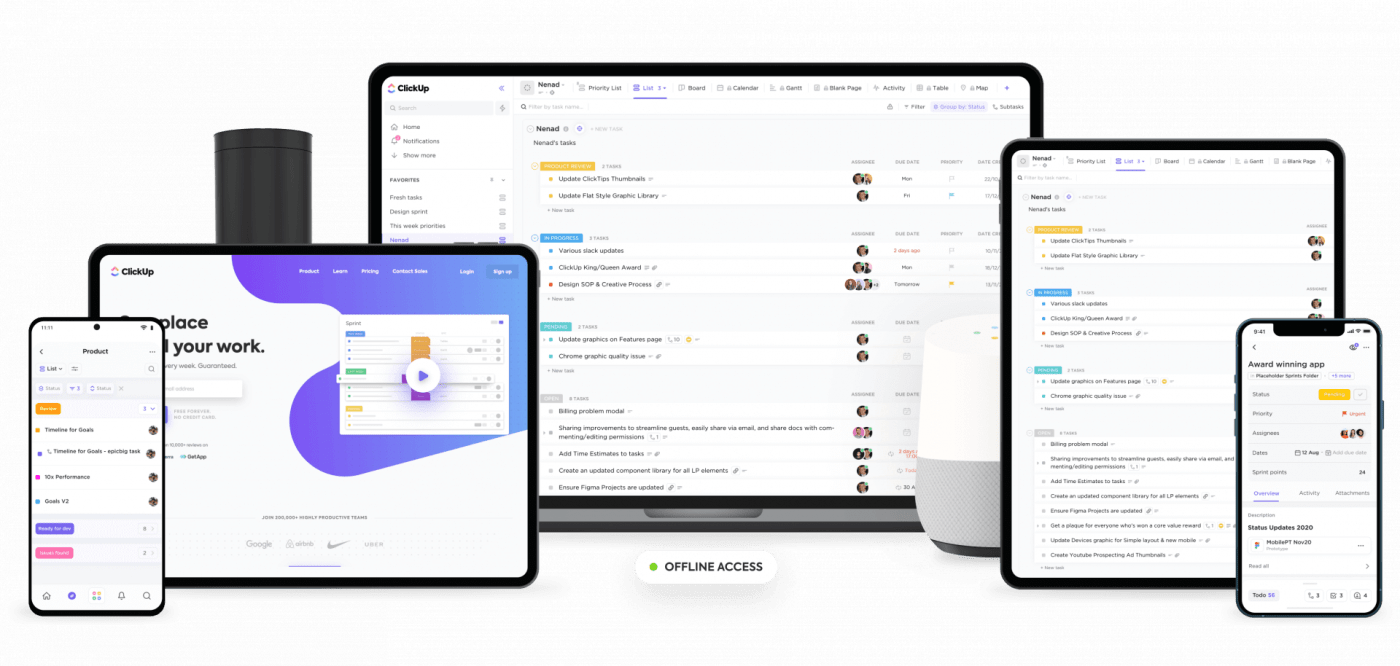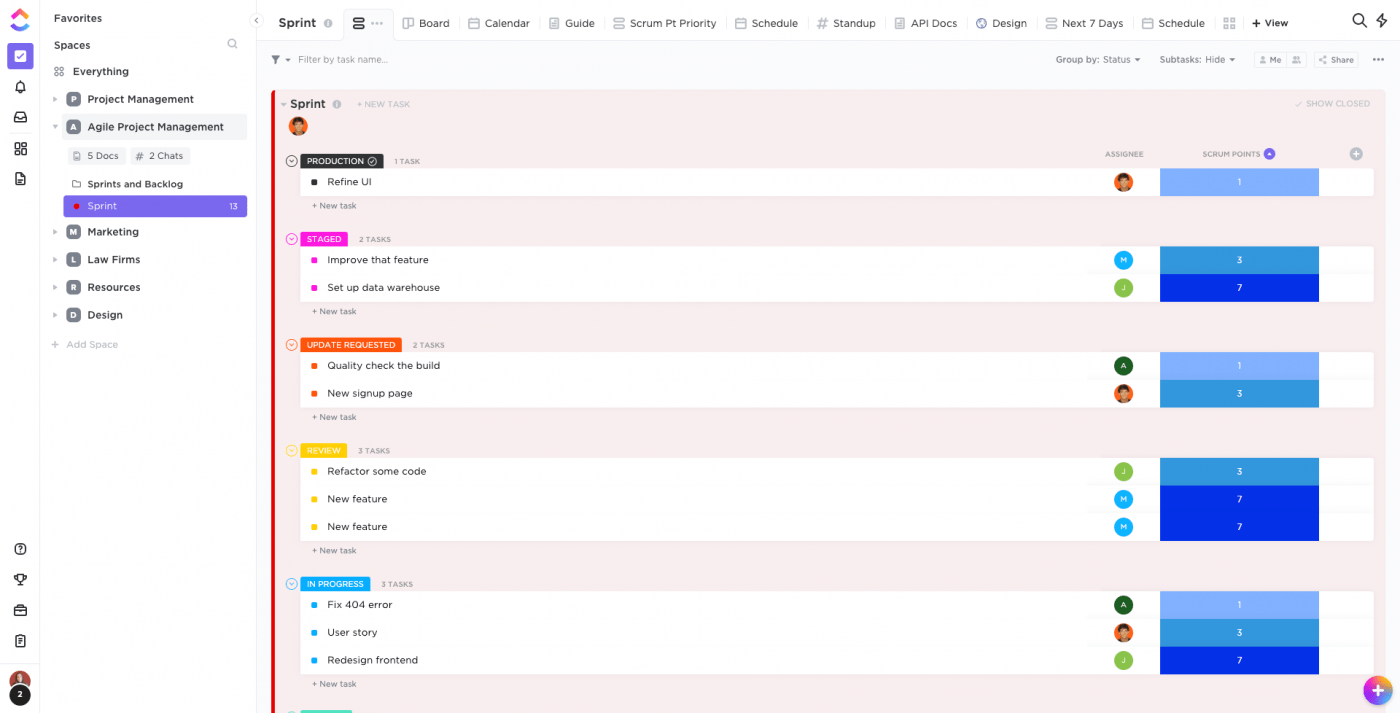

Want to learn about Agile product development?
Whether you’re building software or manufacturing hardware products, the Agile process helps make your development cycle shorter and more productive.
And if you want to learn the basics of the Agile approach, you’re in the right place.
In this article, you’ll learn what the Agile methodology is, how it works, its benefits, and the best Agile project management tool for you.
Let’s get started!
What Is Agile?
The Agile methodology is a set of practices that helps teams reduce the length of the development cycle and build user-centric products.
How does it do this?
An Agile team works in short sprints of 2-4 weeks to build a working version of the product.
At the end of each sprint, they present this version to key stakeholders. Based on the feedback from each stakeholder, they head into the next sprint.
You repeat this process until the final product meets everyone’s expectations.
Why?
Short sprints help you cut down on total production time.
And frequent reviews with the stakeholder helps you stay in touch with customer needs.
The result?
A better product developed in less time!

This is, of course, a very different development style from a traditional project management style like the Waterfall methodology.
How is the Agile framework different from the Waterfall methodology?
An Agile project contains multiple sprints or development cycles, whereas the Waterfall methodology has a single production cycle that could last months or even years.
Moreover, the Agile approach tests the products continuously throughout the development cycle. Waterfall teams conduct product tests only after it’s fully developed.
This means that the customer can review the product only after the production cycle is over. However, in Agile, you actively involve customers throughout the product development process, helping you build superior products.
Who can use the Agile methodology?
While the Agile framework was developed for software development projects, it doesn’t mean that the methodology can’t cater to hardware development or other industries.
In fact, you can adopt the Agile development methodology for all kinds of sectors, such as finance, marketing, and even construction.
Check out our articles on project management software for construction and tips from experts on how to go Agile.
What Is Agile Based On?
The Agile Manifesto is a brief document that summarizes what the methodology stands for. It lays out a set of 4 values and 12 principles for all Agile development teams.
While these aren’t rigid rules you must follow, the values and principles affect every process in Agile software development.
Together, the Agile principles and values develop an Agile mindset among team members, one that’s geared towards maximum collaboration and innovation.
The 4 Agile values are:
- Individuals and interactions over processes and tools
- Working software over comprehensive documentation
- Customer collaboration over contract negotiation
- Embracing change over following a plan
The 12 Agile principles can be split into 4 groups:
1. Agile project management principles about customer satisfaction
- Prioritize meeting customer needs to deliver high-quality, working software within the deadline
- Embrace last-minute changes in requirements
- Keep delivering every couple of weeks or months to get continuous customer feedback and adapt the product accordingly
2. Agile project management principles about quality
- Focus on how well your working product satisfies customers to judge its success
- Maintain a steady development pace to keep up with the test-driven development process
- Pay continuous attention to technical excellence and good design as this improves your team’s agility
3. Agile project management principles about collaboration
- Project stakeholders and developers must actively collaborate throughout the development process
- Build projects around motivated team members and give them the support they need
- Engage in face-to-face conversations as it’s the most reliable and efficient way of conveying information. Encourage team members to communicate directly
- Self-organized teams that work with minimal supervision give the best output
4. Agile project management principles about team management
- To enhance agility, keep your processes simple and get rid of non-essential work
- Evaluate your team’s performance continually and fine-tune them to become a better, more efficient team
What Are the Different Roles in an Agile Team?
An Agile project is like a grand musical. Sets and costumes can come later.
But for it to truly succeed, it needs awesome artists first.

And Agile team members are nothing short of artists themselves!
While they’ll have diverse skills and backgrounds, they all work together to solve the problems at hand. This kind of cross-functional collaboration is the foundation of an Agile team’s culture of innovation.
But who are these people and what are their responsibilities?
Here’s a list of key Agile team members and what they do.
1. Product owner
The product owner (sometimes known as the product manager) is where it all begins.
They’re the supercomputer in the team: the ultimate source of information about customer needs.
A product owner works closely with users, records their requirements, and translates these into the product backlog. And just like a computer, they’re indispensable to all the project processes!
2. Project manager
If the product owner is the source of all customer-related information, the project manager is responsible for putting it to good use.
They coordinate the development team to build a product on the guidelines of the product owner.
More importantly, they keep a close eye on the moving pieces in the project cycle, such as sprints and its various stages.
However, if you’re following the Scrum methodology, a project manager’s role is shared between the product owner, Scrum master, and development team members.
3. Development team
The development team is the army on the ground. They’re involved in product building in a hands-on capacity.
Agile development teams are self-organized, cross-functional teams made up of designers, engineers, programmers, business analysts, etc.
4. Stakeholders
Although project stakeholders don’t have a hands-on role in the development process, their inputs steer the product in the right direction.
The 4 main types of project stakeholders in the Agile methodology are:
- Principals or buyers of the final product
- End users
- Partners who support the production
- Insiders like senior managers or executives
Their needs and vision drive various parts of the product.
What Are the Various Agile Product Development Methods?
The Agile approach isn’t just a product development process anymore.
Over the years, Agile practices have come to represent a larger philosophy about production.
The Agile umbrella covers a wide range of software and hardware development methods.
But they all share one core objective: develop a better product in less time!
Typically, an Agile coach or team should have a working knowledge of the basics of the most common Agile software development methods.
Here’s a brief look at some variations of the Agile development methodology:
1. Scrum
Scrum is almost entirely like the Agile framework, except for a few key differences.
The most significant difference is the presence of a Scrum master who guides the development team.
Additionally, Scrum team members have far more autonomy over their day-to-day operations and work with minimal supervision. However, for this to succeed, they must be sufficiently experienced.
The Scrum framework is better suited for projects that continuously evolve.
To learn more about the Scrum events or ceremonies that make up this Agile development process, click here.
2. Lean
Toyota pioneered a manufacturing process in the 70s that focused on reducing all kinds of waste. This value-driven process, now known as Lean, was further adapted to suit any software production.
The Lean principles help you reduce wastage from excessive inventory, overproduction, overworked team members, etc.
Lean is great for simplifying workflows and delivering only what is valuable to the customer.
3. Kanban
Just like Lean, Kanban project management is also a Japanese invention. However, it takes a visual approach to product development.
Teams use a Kanban board to track each task from start to completion. This encourages transparency and improves the team’s capacity to spot and tackle bottlenecks.
4. XP
Extreme Programming, or XP for short, also shares almost all core principles with Agile (just like Scrum).
However, it has several specific engineering practices for software development, like testing, refactoring, and pair programming.
XP also focuses on creating consistent project phases for developers, making it an excellent choice for complex projects.
How Does Agile Product Development Work?
You now know the basics of Agile.
But you may be wondering how it works on the ground.
Don’t worry. We got you covered.
The typical Agile process is fairly simple to understand.
It only has two important phases:
- Planning
- Sprints
In this section, we’ll get down to the nuts and bolts of both and explain how they progress.
To make things fun and simple, we’ll use an example Agile project of our own!
We’ll try to build a pizza delivery app that aggregates the best deals for its users.
Makes you hungry for knowledge?

Let’s dive into the Agile development process for this project then!
Phase #1: Planning
Your pizza delivery app works to help users save time that they would otherwise spend browsing through deals and menus.
So why should your project plan waste any time either?
Efficient Agile planning mainly focuses on these 4 areas:
A. Product vision statement
This is a simple, one-line description of what your product is set to achieve.
Once the project begins, every action you take should trace back to the vision statement.
It should be specific enough to narrow down on your intent, but broad enough to accommodate various possibilities during production.
Example: To give people the choice of best pizzas at the lowest prices.
B. Product roadmap
The product roadmap highlights all the key features that make a functional product.
You may also add a list of USP (unique selling proposition) features that set your product separate from the market standards.
Example: A feature that lets users compare the prices and delivery time for pizzas among various restaurants.
More importantly, since it’s a ‘roadmap’, it lays out a rough production timetable for the team.
C. Product backlog
A product backlog contains all items from the Agile roadmap. However, it’s not just a to-do list.
It’s developed and managed by the product owner, who adds priorities and estimates to each feature in it.
Additionally, product backlog items are assigned to the development team based on their priority.
However, the product backlog is not frozen in time.
Anytime the product owner gains new insight into customer behavior, the backlog too can change to adapt to meet customer needs.
D. Release plan
Once you’ve planned your backlog, you can set a release plan for different sets of features that’ll be developed during various sprints. The output of each sprint is known as an ‘increment’.
Example:
Sprint 1: Create user onboarding features
Sprint 2: Develop pizza comparison features
Bonus: Check out more product management templates here.
Phase #2: Sprints
If the planning stage is like writing the screenplay for a movie, sprints are when you shoot the film!

All the production activity happens in sprints that are between 2-4 weeks long.
It’s also the stage when testing, reviews, and changes happen.
This makes sprints the longest, the most resource-intensive, and the most productive part of the Agile product development process.
Here’s how one sprint cycle of the Agile product management process is conducted:
A. Sprint planning
The release plan narrows down the broader agenda for each sprint.
But it’s only in the sprint planning session that the team decides how to achieve it.
For example, the product backlog mentions that the onboarding process is a priority and needs to be completed in the first sprint.
In the first sprint planning meeting, the team will decide what tasks and subtasks this requires. This list is called the sprint backlog.
The tasks mentioned in the sprint backlog are then assigned to team members, along with specific objectives and deadlines.
In short, the sprint planning process lays out a path for the sprint.
All your team has to do now is work on it.
B. Daily standup
Agile values insist on face-to-face interactions for better coordination.
Especially when the work is in full swing during sprints.
The daily standup is a way of improving such communication.
In this, the development team meets for 15 minutes every morning to discuss the previous day, plan for the day ahead, and any potential roadblocks in their way.
These daily meetings are short enough to avoid drawn-out discussions but long enough to share highlights of the day.
And just like a good pizza, a slice of it can fill you up!

C. Sprint review
After weeks of working at a feverish pace to finish the sprint backlog, the team delivers an increment. The team presents this working software to the key stakeholders at the sprint review meeting.
This is an opportunity for the team to gauge the user’s live feedback and identify any changes they need to make.
At this stage, your product is like a pizza base with some sauce and toppings.
If the ingredients are right, a little heat (or feedback) will only make it a better product!
D. Sprint retrospective
An Agile team focuses on improving with every sprint.
That’s why after the review, before heading into the next sprint, they pause to conduct a retrospective.
This meeting is an internal review of what worked and what didn’t in the previous sprint.
The team uses this information to improve themselves in the next sprint.
And with each version of the working software, they come closer to the final product.
The 3 Key Benefits of Agile Product Development
You’ve now understood how different the Agile method is from traditional production practices.
But why should you use it?
Here are the 3 key benefits of going Agile:
1. Faster communication and better-informed stakeholders
Poor communication is one of the biggest reasons for project failure.
But the Agile process insures against this by putting communication at the center of the project.
- Team members interact with each other every day in their daily standups
- The product owner, as a representative of the customer, is part of every process
- Reviews after each sprint encourage direct stakeholder participation in the production process
And throughout the project, teams depend on face-to-face interaction over any other kind.
It’s truly the fastest way of getting things done!
2. Develops an innovative environment
Can you expect team members to be innovative if you also require them to draft tedious documents and report to a dozen people?

Agile creators recognized how too many processes discourage innovation.
And that’s why Agile principles are clear about what the team’s priorities should be.
An Agile team focuses on delivering working software in multiple iterations.
While traditional methods focus on achieving perfection in one take, Agile emphasizes a ‘trial and improve’ method. That’s why the Agile environment is a powerhouse of design thinking and creativity.
3. Faster production cycles
Here’s a horror story for a developer:
Working on a product for months on end only to realize that it doesn’t meet customer expectations at all!
Yup, it’s the stuff of nightmares.
It’ll knock you back to the stone ages of your project!
Thankfully, in an Agile project, you can maintain a steady pace of production and reviews.
Customer collaboration will give you feedback from the users during the production and testing phases.
Moreover, as the sprint duration is capped at 2-4 weeks, there’s a natural barrier to any delay in the product development process.
If you want to learn more about the benefits of the Agile software development, our team has compiled 6 more reasons in this post.
All of this will keep you on the fast track to develop a market-ready product.
But hey, all of these advantages don’t make building a product any easier.
You still have plenty of problems to solve, like:
- How can you get a team to communicate effortlessly with each other and the stakeholders?
- How do you keep track of your team’s agility?
- How can you track the dizzying pace and hundreds of sprint activities?
Dozens of questions. Single solution.
You need a powerful project management tool.
And not just any tool; you need the best one on the market, ClickUp.
The Best Agile Project Management Tool of 2022: ClickUp

With a wide variety of Agile product development and collaboration features, ClickUp’s got everything to support any Agile team (in-house and remote)!
Here’s how some ClickUp features support the Agile product development process:
A. Manage sprints with Sprint Lists and Sprint Points
Sprints are the longest phases in the Agile development process, each one a minefield of fast-paced activities.

Of course, you can’t afford to miss a single piece of information.
But how can you manage sprints without extensive documentation?
Just use ClickUp’s Sprint Lists feature.
These are simple checklists that divide each sprint into small tasks. You can check off the tasks from the list as you progress through the product roadmap.
You can create a checklist for all your Agile projects, tasks, subtasks, and even your user stories. Add Scrum points to a list to figure out how long you’ll take to finish the backlog items.

But that isn’t all.
You can’t manage a sprint without some sprint points attached to it, right?
To help you monitor your workload capacity, ClickUp lets you add Sprint Points for efficient resource management. This is especially useful when you’re using the Timeline view to organize your schedule.
How?
As you can easily add Sprint Points to your tasks, you can better determine everyone’s capacity for better work allocation.

And if that wasn’t helpful enough, ClickUp lets you choose your own point system. Whether you prefer the Fibonacci sequence (1,2,3,5,8), the linear numbering system (1,2,4,8) or anything else – ClickUp can handle it!
B. Get a complete overview of projects on Dashboards
Whether your Agile team works remotely or in the same office, they need to stay on top of their projects.
The ClickUp Dashboard feature steps in to fulfill this need.
It’ll give you quick visual summaries of the whole project to ensure that things are running smoothly.
Moreover, you can even customize your Dashboard with sprint widgets such as:
- Burndown Charts: the amount of work remaining in a project
- Burnup Charts: the amount of work already completed in a project
- Velocity Charts: task completion rate
- Cumulative Flow Charts: task progress over time

C. Communicate effortlessly in the Comments Section
Agile replaces long, aimless meetings with quick, summary updates.
And ClickUp encourages swift and clean communication among teams with its Comments Section.
Use it for:
- Detailed conversations: regarding a specific task, activity, or assignment
- Tagging team members: to alert them of important comments
- Sharing documents and files: related to the project

But are you worried that the sea of comments about bug fixing will overwhelm the product team?

Don’t worry, ClickUp’s Assigned comments feature has your back.
Convert any comment into a task and assign them to yourself or another team member. ClickUp notifies the team member and shows the comment in the Home tab in their inbox so that they don’t miss it.
Once they’re done with the task, they can simply resolve the comment to indicate task completion.

D. Invite stakeholders to collaborate with Custom Access Rights
Regular customer collaboration makes the Agile method unique.
And ClickUp’s Custom Access Rights feature enables it.
The feature helps an Agile product manager share your project files, folders, and task lists with anyone outside your workspace.

But you still retain complete control over what ‘permissions’ the stakeholder is granted.
Some example permissions are:
- Can view: to view project details but not interact
- Can comment: to comment on the tasks and task lists
- Can edit: to edit tasks but not create them
- Create and edit: to create their own tasks and subtasks
- Can delete: to delete tasks that they did not create
But that’s not all.
ClickUp offers an amazing variety of project management features to aid Agile transformation, like:
- Goals: split your sprint goals into easier to achieve Targets
- Priorities: attempt the most important tasks first
- Multiple Views: choose from various project views like List view, Board view, Box view, Calendar view, and Me Mode
- Weekly Scorecards: track your developer team’s objectives and goal progress quickly
- Pulse: know what tasks your remote or in-house team is most active in during a period
- Automation: automate 50+ repetitive project processes to save time
- Gantt charts: get a complete overview of your project’s timeline at one glance
- Chat view: easily access all your project-related conversations
- Powerful iOS and Android mobile apps: for on the go work collaboration
Conclusion
An Agile product development process will take your organization’s productivity to the next level.
Not only will you develop more user-centric products, but you’ll also spend less time and resources in the process.
But to adapt to the Agile method (and keep up with it), you’ll need the right tech to support you.
So why not sign up for ClickUp today?
ClickUp’s designed especially for Agile teams and focuses on unlocking their potential.
From sprint lists to detailed reports, it has everything you need.
ClickUp will take care of all the herculean project stuff while you can focus on helping your Agile team shine!




